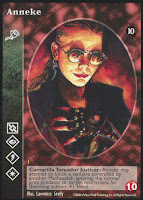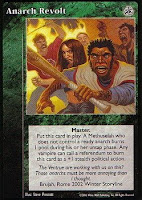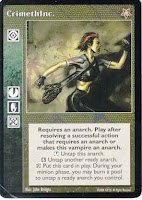
The "
Anson Master Cards" (or short: "
Anson") deck) is, of course, based on "
Anson's" special ability to get two master phase action each turn. It runs an insanely high count of master cards, usually something between 30 to 50 master cards, but sometimes even highter than that. The "
Anson Master Cards" deck has won a couple of tournaments, but since the text of "
Anarch Revolt" has been revised, the deck archetype ceased to appear in tournaments. Nowadays other "
Toreador" decks like "
Aching Beauty" or "
Toreador Grandball" archetypes are more successful in tournaments.
How to win with themThere's a good reason why a player is (usally) only allowed to play a single master card each turn, that is master cards are (often) the strongest cards in the game. The "
Anson" deck archetype is trying to exploit this strength by playing two to three master cards each turn. The third master phase action is usually aquired by putting "
Parthenon" into play.(1)

The deck's role during the game is mostly
very passive; during its minion phase the deck almost never does anything, apart from calling an occasional vote like "
Parity Shift". In other player's turn it resorts to blocking, but only to end combat with "
Majesty" or "
Obedience". So how the's deck going to win if doesn't do anything or little while acting (or blocking)? The answer
was "
Anarch Revolt".
The old version of "
Anarch Revolt" dealt one pool damage to a player in his untap phase, while the new version does only so if you do not control a ready Anarch. Having a number of "
Anarch Revolts" in play had much greater ousting potential before the card text was changed, especially if you could "
defend" them by having the vote majority (with "
Anson", "
Anneke", etc.) at the table and playing "
Delaying Tactics" in addition.
"
Delaying Tactics" is quite o.k. when trying to keep at least one "
Anarch Revolt" in play. This is because in a given turn the "
Delaying Tactics" "protects" a particular "
Anarch Revolt" to be removed by vote. But if you have multiple "
Anarch Revolts" in play the vampires of the acting player can still try call referendum to remove the other "
Anarch Revolts" in play despite a "
Delaying Tactics" against the "
first" "
Anarch Revolt" played in the same turn. Check this thread in the
Usenet newsgroup for all its gory rule details. With "
Anthelios, the Red Star" and "
Anson" it is also possible to retrieve the same "
Anarch Revolt" that was removed since your last turn
and play it in the same master phase.
So the main task is two play one, two or even three "
Anarch Revolts" in same turn, in the mid- to long run not many decks can cope with that pool loss. To make things worse for the other players, you can retrieve the "
Anarch Revolts" with "
Anthelios" and replay them immediately with "
Anson's" special. This is very efficient, since you need your master phase actions for the many other master cards to play. But you can use the potential as argument, so other players are dettered from removing the "
Anarch Revolts".
Another angle to destroy its prey's resources (read: vampires) can be "
Golconda: Inner Peace" and "
Hostile Takeover" (if some "Ventrue" is added to the crypt). "
Golconda" can also be used to gaining pool by playing a "
Minion Tap" on "
Anson" first to empty him, and then burning him with "
Golconda" to gain another 8 pool. "
Golconda" is also good for defending "
Anson", i.e if he's in torpor or if some nasty master card was played on him like "
Pentex Subversion" or "
Fame". So burn "
Anson" and bring out another copy of him this turn (at least a turn later).
The deck can deal moderately, there are a few options to help or harm players crosstable but not too many. Among these are "
Golconda" and "
Hostile Takeover" for removing vampires or "
Parity Shift" for distributing pool. But most important are the "
Life Boons" where you can give players enough pool so that they won't get ousted by the
wrong player.
 Crypt Selection
Crypt SelectionThe crypt is focussed on "
Anson" for he's providing the extra master phase action (beside the "
Parthenon") needed for the deck. The second choice for the deck is "
Anneke" since she's also a "
Toreador", has a "
Justicar" title and a great special ability (built-in-"
Eagle Sight"). But the crypt can be filled up with a couple of different choices. Likely candidates are "
Democritus" for contesting cards, "
Huitzilopochtli" for
another master phase action or "
Alexandra" for extra votes (and possibly her special ability).
Bleed defenseThe deck has two options to deal with bleed, the first is using "
Anson's" (inferior) "
Dominate" to use "
Deflection" to bounce the bleeds. "
Telepathic Misdirection" is only added if there are other vampires in the crypt who have superior "
Auspex". The second option is to regain pool as fast as the bleed deck applies damage to you. This is usually done by playing "
Minion Tap" and "
Golconda" and (if included in the deck) "
Parity Shift".
Vote defenseThe first and most important defense against political decks, and in this deck's case against the removal of the "
Anarch Revolts", are their permanent votes starting with those "
Anson", but also from additional vampires in the deck like "
Anneke". Furthermore the usual vote defense with "
Delaying Tactics" and "
Direct Intervention" works for this deck too. As detailed above "
Delaying Tactics" can prevent removing a particular "
Anarch Revolt" for whole turn, but it's hard to protect multiple "
Anarch Revolts" in play if you don't have vote lock.
Combat defense"
Majesty" and "
Obedience" are the cornerstones of the combat defense. Usually "
Anson" or any other vampire with "
Dominate" will stay untapped and if they got rushed, play "
Obedience" to avoid combat. Since "
Anson" only has inferior "
Dominate" this untaps the acting vampire, but on the other hand he cannot perform the action again that turn (unless it was a hunt action or something similar). E.g. a rush combat deck needs to use a different rush card for that minion to attack again that turn, or a bleed deck cannot bleed with the same minion again that turn. "
Majesty" is the second line of defense here, if "
Anson" is tapped and cannot play "
Obedience". "
Majesty" is also quite handy
if "
Anson" wants or is forced to take an action, which will
not happen frequently.
How to win against themBefore the rewording of the card it was quite hard to beat deck. It has quite good pool gain, the "
Anarch Revolts" are not easy to remove if you didn't play a vote deck yourself, and combat decks have difficulties getting in combat due to "
Obedience" and "
Majesty".

Good chances against this deck archetype which can deliver persistent pressure. For example a bleed deck can deliver consistent pool damage to the "
Anson" deck and leverage the "
Anarch Revolts" against their controlling player. Also Weenie Rush or Multi Rush decks can be quite efficient against a master card deck. Though a couple of combats can be averted by "
Obedience" and "
Majesty", persistent attacking will led to torporizing "
Anson" (or his companions). Only make sure to diablerize "
Anson" when he's in torpor, otherwise "
Golconda" played on "
Anson" will ruin most of your efforts.Intercept decks will have very hard time, the "
Anson" deck will avoid taking any actions in front of an intercept deck. In case of the wall deck playing "
Smiling Jack", a "
Toreador Grandball" can be used to remove the "
Smiling Jack".
Removing the "
Anarch Revolts" seem futile, but if you can spare the action, and you are able to or convince the rest of the table to) remove the "
Anarch Revolts", you should do so. Yes, your opponent can still use two master actions and "
Anthelios" to retrieve the card and replay it, but on the other hand then he's not playing a "
Minion Tap" and retrieve a "
Direct Intervention" for example.

After the rewording, defense against the deck is often easy. Make an Anarch or two and you're immune against the deck. The immunity clause on "
Anarch Revolt" has spawned a different type of deck. The "
Anarch Revolt" deck nowadays, have a couple of Anarch vampires and a small number of "
Anarch Revolts" in play. In order to make the "
Anarch Revolts" effective, they kill the Anarch vampires of their prey. But as I said this is another type of deck ... Anyhow the "
Anson" deck is not really capable of removing vampires in a reliable way, so the "
Anarch Revolts" are not working anymore as reliable as before.
Key Cards- "Anson" -- his special is the key to the deck archetype.
- "Parthenon" -- gives another extra master phase.
- "Obedience" / "Majesty" -- combat defense, read: avoidance.
- "Parity Shift" "Voter Captivation" -- basic combo to damage your prey and bloat at the same time.
- "Minion Tap" / "Golconda" -- "Minion Tap" is first part of the bloat mechanism, while "Golconda" is the second as well as the failsafe if "Anson" is torporized.
Notable Examples & VariationsThere are some variants of the deck, mostly there are slight difference in crypt selection, and if and which political actions to pack into the deck.
- "The Master's Voice" by Rob Treasure -- basic variant with "Anarch Revolts" and a few votes.
- "Toreador master deck" by Riku Niittymäki -- omits the political actions, and can oust without taking a single action.
- "Anarch Revolt" by Kevin J. Wiebe -- adds a "Dominate" weenie horde for extra bleed/ousting power.
- "Anneke+Anson" by Ruben Van Cauwenberghe -- mixes the "Anson master card" deck with a "Toreador Grand Ball" deck.
Sample DecklistDeal with the Devil
Paris, France
07/03/04
20 players
Deck Name: Anson Master
Created By: Kamel Senni
Crypt: (17 cards, Min: 32, Max: 36, Avg: 8,23)
----------------------------------------------
15 Anson aus dom CEL PRE 8 Toreador
1 Huitzilopochtli AUS DAI DOM OBF PRE POT 10 Baali
1 Democritus aus cel for DOM PRE 10 Ventrue
Library: (90 cards)
-------------------
Master (73 cards)
9 Anarch Revolt
1 Antediluvian Awakening
1 Art Museum
1 Barrens, The
1 Bleeding the Vine
5 Dreams of the Sphinx
5 Fortschritt Library
1 Giant`s Blood
7 Golconda: Inner Peace
4 Hostile Takeover
1 Information Highway
3 Life Boon
1 Malkavian Dementia
9 Minion Tap
7 Parthenon, The
2 Personal Involvement
3 Recruitment
3 Storage Annex
1 Succubus Club
2 Sudden Reversal
1 Temptation of Greater Power
5 Visit from the Capuchin
Reaction (14 cards)
4 Delaying Tactics
10 Obedience
Combat (2 cards)
2 Staredown
Event (1 cards)
1 Anthelios, the Red Star




























